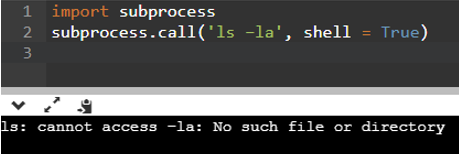
What is Save Process Output (stdout) in Subprocess in Python? Now, use a simple example to call a subprocess for the built-in Unix command “ls -l.” The ls command lists all the files in a directory, and the -l command lists those directories in an extended format.Īs simple as that, the output displays the total number of files along with the current date and time. It may also raise a CalledProcessError exception.
Get data return from python subprocess call code#
If there is no program output, the function will return the code that it executed successfully. The Python subprocess call() function returns the executed code of the program. Return Value of the Call() Method from Subprocess in Python shell: It is the boolean parameter that executes the program in a new shell if kept true.stderr: This handles any errors that occurred from the standard error stream.stdout: It is the standard output stream’s obtained value.stdin: This refers to the standard input stream’s value passed as (os.pipe()).You can pass multiple commands by separating them with a semicolon ( ) args: It is the command that you want to execute.The call() method from the subprocess in Python accepts the following parameters: Subprocess.check_call(args, *, stdin=None, stdout=None, stderr=None, shell=False) Parameters of Subprocess Call() The syntax of this subprocess call() method is: Subprocess in Python has a call() method that is used to initiate a program. The “stdout” handles the process output, and the “stderr” is for handling any sort of error and is written only if any such error is thrown. In the above code, the municate() is the primary call that reads all the process’s inputs and outputs. Process = Popen(, stdout=PIPE, stderr=PIPE) It is like “cat example.py.” You can start any program unless you haven’t created it. The cat command is short for ‘concatenate’ and is widely used in Linux and Unix programming. In the example below, you will use Unix’s cat command and example.py as the two parameters. The first parameter is the program you want to start, and the second is the file argument. It is possible to pass two parameters in the function call. To start a new process, or in other words, a new subprocess in Python, you need to use the Popen function call. You can also get exit codes and input, output, or error pipes using subprocess in Python. So, if you want to run external programs from a git repository or codes from C or C++ programs, you can use subprocess in Python. It lets you start new applications right from the Python program you are currently writing. These simple but very powerful lines of code allow to interact with HDFS in a programmatic way and can be easily scheduled as part of schedule cron jobs.Subprocess in Python is a module used to run new codes and applications by creating new processes. z: if the file is zero length, return 0.Ĭmd = HDFS Command to remove the entire directory and all of its content from HDFS.

Hdfs dfs -rm -skipTrash /path/to/file/you/want/to/remove/permanently Run Hadoop copyFromLocal command in Python

Proc = subprocess.Popen(args_list, stdout=subprocess.PIPE, stderr=subprocess.PIPE)ģ-Examples of HDFS commands from Python Run Hadoop ls command in Python Print('Running system command: '.format(' '.join(args_list))) It is passed as a Python list rather than a string of characters as you don't have to parse or escape characters. We will create a Python function called run_cmd that will effectively allow us to run any unix or linux commands or in our case hdfs dfs commands as linux pipe capturing stdout and stderr and piping the input as list of arguments of the elements of the native unix or HDFS command. Or we can use the underlying Popen interface can be used directly. The recommended approach to invoking subprocesses is to use the convenience functions for all use cases they can handle. To run UNIX commands we need to create a subprocess that runs the command.

The Python “subprocess” module allows us to: Interacting with Hadoop HDFS using Python codes


 0 kommentar(er)
0 kommentar(er)
